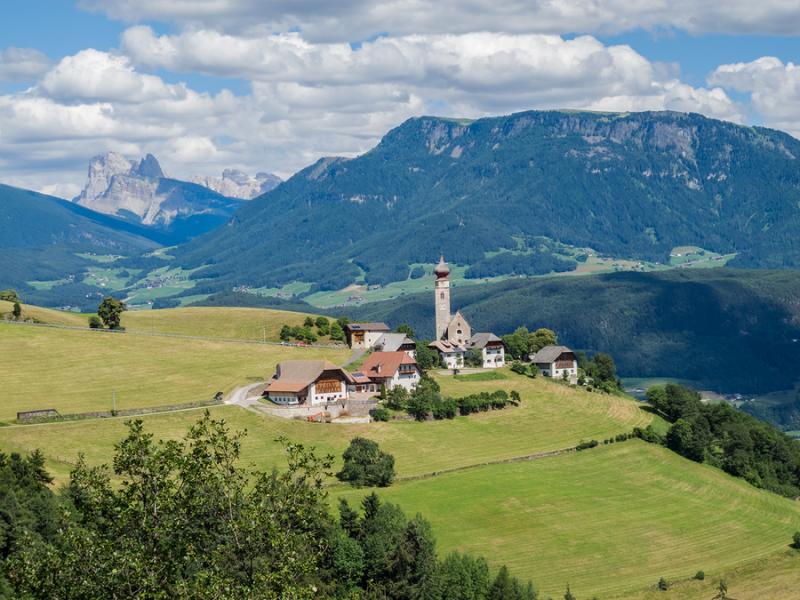[The idyllic Renon plateau has breathtaking views of the Dolomites.]
“Here on the Renon it’s divinely beautiful,” wrote Sigmund Freud as he vacationed on the Renon mountain plateau above Bolzano in the summer of 1911.
Il Renon, as it’s known in Italian, hovers above the regional capital of Alto Adige/South Tyrol at an altitude varying between 900 and 1300 meters, between the valleys of the Talvera and Isarco rivers, bordered to the north by the Corno del Renon, the highest mountain on the plateau (2261m) which affords great panoramic views of the Dolomites.
The delightfully quiet Renon plateau is such a contrast with the hustle and bustle of Bolzano, although it’s only separated by a quick trip via the spectacular Renon cable car, which, in 12 minutes, covers a 1,000-meter elevation gain (amazing views of Bolzano, the plateau itself and the mountains all around!), transporting you into a completely different atmosphere.

[Typical Tyrolean church at Longomoso.]
Wealthy Bolzano residents have vacationed on the Renon since the 1800s, and it is said that the German term "Sommerfrische" (high-altitude summer coolness) was first used by the Bolzano bourgeoisie in Soprabolzano, the village ‘above Bolzano’, which is also the arrival point of the cable car.
The Renon seems to have maintained the same rhythms and simplicity of the times when Freud vacationed there. It’s a good place to be if you’re looking for some peace and solitude, and restorative walks in nature. It’s also a chance to experience that part of Italy that feels more Austrian than Italian, as South Tyrol was until World War I part of the Austro-Hungarian Empire; and on the Renon, as in many other parts of the region, they’re proud of their German heritage. They often address you first in German; the houses and churches are typically Tyrolean, and the cuisine a delicious mix of German and Mediterranean flavors.
A good way to experience the Renon is on foot of course as numerous, well-marked trails in the woods lead to alpine farms, pastures, picturesque little lakes, like Costalovara, and the bizarre ‘earth pyramids, cone-shaped pillars formed by deposited clay and a boulder on top, forming unusual shapes that are constantly evolving due to erosion, until a final collapse leaves room for new formations.

[The earth pyramids on the Renon.]
An easy way to savor the atmosphere and the views is the Freud Promenade (trail number 35; 5.5 km, approx.. 1h20min), so called as a homage to the founder of psychoanalysis; it connects the village of Soprabolzano to the village of Collalbo along a path in the woods, which at times opens up to reveal beautiful views of some of the most famous peaks of the Dolomites, including the Sciliar, Catinaccio, Sassolungo and many more.
When you get to Collalbo, you should keep walking for another 40 minutes to reach one of the most idyllic views of the Renon: the ‘earth pyramids’ with the Odle and Sciliar Dolomites in the background and the classic church with the onion-shaped bell tower making for the perfect picture postcard.
Return via the narrow gauge train (or ‘trenino del Renon,’), the historic little train in operation on the Renon since 1907. At the time, it actually took travelers from the main square Piazza Walther in the heart of Bolzano up to the plateau, puffing up the mountain covering an elevation gain of 1000 meters. It was designed on the model of Swiss mountain railways. Today, it connects the two main villages of the plateau (Soprabolzano and Collalbo), and provides a fun experience while enjoying the views.
Other ideas for walks include the final stretch of the ‘Chestnut trail,’ which is especially beautiful to walk in the fall season, when chestnuts form a carpet along the trails, and you can take part in the Torggelen, an old tradition which coincides with the pressing of the grapes and involves tasting the new wine accompanied by typical South Tyrol fare, such as canederli, sausage, speck, Schlutzkrapfen (spinach and ricotta ravioli), Schuttelbrot (thin and crunchy rye bread), barley soup, apple juice and, of course, chestnuts. (In case you weren’t aware, South Tyrol has 26 Michelin-starred restaurants, the highest concentration in Italy.)

[Pine forest and the Dolomites in the background - the Renon is such a beauty.]
More adventurous walkers should head to the Corno del Renon. When you get off the cable car that takes you close to the top, go for a walk in the lovely mountain pine wood to smell the pino mugo’s intense, resinous fragrance. At the top of the Corno di Renon, you’ll enjoy one of the most panoramic views of the Dolomites, over the Alpe di Siusi, Catinaccio, Sciliar, Odle, Latemar, Sass de Putia, Marmolada glacier, and the glaciers that divide Italy from Austria.
For more information: https://www.ritten.com/?l=en




